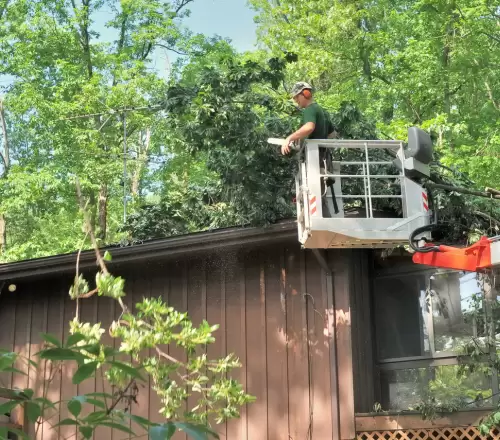Maintaining a beautiful and well-kept yard doesn’t have to break the bank. Trees play a crucial role in enhancing the aesthetics of your landscape, providing shade, and even increasing property value. However, without proper maintenance, they can become overgrown, diseased, or even hazardous. Many homeowners shy away from tree trimming due to the perceived high costs of professional services. Fortunately, there are plenty of cheap tree trimming service solutions that can help you keep your yard in top shape without draining your wallet. In this guide, we’ll explore budget-friendly ways to trim trees effectively and safely while maintaining the health and beauty of your landscape.
Why Tree Trimming is Essential
Before diving into cost-effective strategies, it’s essential to understand why tree trimming is necessary:
- Promotes Tree Health: Removing dead or diseased branches prevents decay from spreading and encourages healthy growth.
- Enhances Aesthetic Appeal: Well-trimmed trees make your yard look neat and visually appealing.
- Improves Safety: Overgrown branches can pose hazards, especially during storms, by falling onto property or power lines.
- Encourages Fruit and Flower Production: Proper pruning can stimulate better yields for fruit-bearing and flowering trees.
- Prevents Structural Damage: Overgrown branches can damage roofs, fences, or other structures when left unchecked.
Affordable Tree Trimming Methods
1. Do-It-Yourself (DIY) Tree Trimming
One of the most cost-effective ways to trim trees is by doing it yourself. While professional services can be expensive, with the right tools and knowledge, you can maintain your trees on your own. Here’s how to do it safely and efficiently:
- Use the Right Tools: Basic tree trimming tools include pruning shears, loppers, a handsaw, and a pole pruner. You can find affordable versions of these at home improvement stores or online.
- Follow Proper Trimming Techniques: Avoid over-pruning and ensure you cut branches at the correct angle to promote healthy regrowth.
- Trim at the Right Time: The best time for trimming depends on the tree species, but in general, late winter or early spring is ideal to encourage strong growth.
- Prioritize Safety: Always wear protective gear, including gloves and safety goggles. If using a ladder, ensure it’s stable before climbing.
2. Borrow or Rent Tools
If you don’t have the necessary tools, instead of purchasing expensive equipment, consider borrowing from friends, family, or neighbors. Many communities also have tool-sharing programs that allow homeowners to borrow pruning tools at little to no cost. Alternatively, you can rent equipment from a local hardware store, which is a cost-effective option if you only need them occasionally.
3. Join a Neighborhood Trimming Group
Many neighborhoods have groups of homeowners who share landscaping tasks to reduce costs. By working together, you can share the expense of renting equipment, splitting the cost of disposal, or even assisting each other with trimming tasks. This can significantly cut down costs while fostering a sense of community.
4. Hire Local Handymen or Small-Scale Professionals
While professional tree services can be costly, many local handymen or small-scale landscapers offer trimming services at lower rates than big tree care companies. Look for individuals who specialize in yard maintenance and negotiate fair pricing for small-scale trimming jobs.
5. Look for Discounted or Free Services
Some cities and municipalities offer free or low-cost tree trimming services, especially for hazardous trees. Check with your local government or utility company to see if they have programs in place. Additionally, arborist training programs at community colleges sometimes offer discounted services for practice purposes.
6. Utilize Natural Mulching Instead of Hauling Away Branches
Disposing of tree branches can be costly, especially if you have to pay for yard waste pickup or landfill fees. Instead, consider repurposing trimmed branches for natural mulch, firewood, or compost. This reduces waste and saves money on additional landscaping materials.
7. Schedule Trimming Regularly
Regular tree maintenance prevents the need for drastic, expensive trimming sessions. By keeping up with light pruning throughout the year, you can avoid excessive overgrowth and reduce costs in the long run. Small, frequent trims require fewer tools and less labor than large-scale tree removals.
8. Post Your Need on Community Boards
Websites like Craigslist, Facebook Marketplace, and Nextdoor often have local professionals or individuals willing to perform tree trimming at lower costs than major landscaping companies. Posting about your needs may connect you with affordable options within your community.
Safety Tips for DIY Tree Trimming
While saving money is important, safety should always be a priority. Here are some essential safety tips:
- Never Trim Near Power Lines: If a tree is close to power lines, contact your utility company instead of attempting to trim it yourself.
- Avoid Cutting Large, Heavy Branches: Large branches require special equipment and techniques. If the job is too big, it’s best to hire a professional.
- Use Proper Ladder Techniques: Ensure your ladder is on stable ground, and never overreach when cutting branches.
- Be Aware of Tree Health Issues: If you notice signs of disease, infestation, or structural weakness, consult an arborist before trimming.
When to Call a Professional
Although DIY methods can save money, some situations require professional help. Consider hiring a professional if:
- The tree is too large for you to handle safely.
- Branches are near power lines or buildings.
- You’re dealing with diseased or pest-infested trees that need expert care.
- You lack the proper tools or knowledge to perform the job safely.
Final Thoughts
Keeping your yard beautiful doesn’t have to be expensive. With strategic planning and cost-effective techniques, you can maintain healthy and well-trimmed trees without overspending. Whether you choose to do it yourself, join a neighborhood trimming group, rent tools, or hire local small-scale professionals, there are plenty of affordable options available. By taking the time to trim your trees regularly, you’ll not only enhance your property’s aesthetic appeal but also improve safety and promote healthy tree growth—all while staying within your budget!

